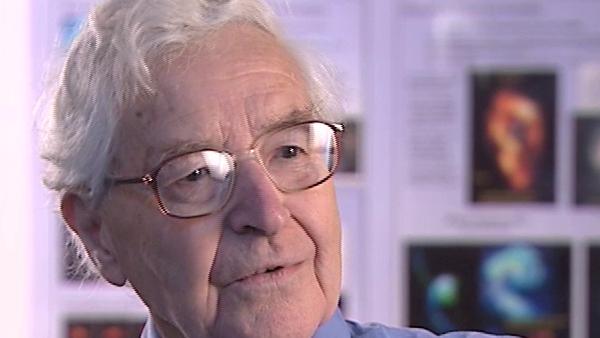NEXT STORY

Pulsars and the Square Kilometre Array
RELATED STORIES

NEXT STORY

Pulsars and the Square Kilometre Array
RELATED STORIES


|
Views | Duration | |
|---|---|---|---|
| 31. Developing the department of radio astronomy | 46 | 06:23 | |
| 32. Martin Ryle's ill health and new directions for the group | 64 | 08:22 | |
| 33. New directions in the group | 48 | 02:33 | |
| 34. Pulsars and the Square Kilometre Array | 66 | 02:14 | |
| 35. Physics versus astronomy | 68 | 04:35 | |
| 36. The importance of pulsars | 73 | 05:40 |

I should also say, of course, another powerful development at that time was John Baldwin’s optical interferometer, which was a world breaking piece of research, devising an optical analogue of our synthesis telescopes, but working at optical wavelengths. That pioneering work – I think John Baldwin hasn’t really received the recognition he should for that, to be honest – it was an amazing piece of work and that… that happened while I was head of the group and… and I was immensely keen to see… see that flourishing. But that… when that became… when it became clear that John Baldwin had made a major breakthrough there and that you could plan a much bigger instrument on a really good site to develop this, just like our early work on synthesis led to the 5-km telescope, John Baldwin himself wasn’t interested in… in building a huge international team, not the slightest bit. He was a bit more like me: he was interested in running his own research, doing new things and developing as far as he could. And… and he really handed over the international development of his ideas to other younger scientists who had been research students with him. And now the… the optical interferometer in Socorro, in New Mexico rather, is… is proceeding in an expensive way and… and, really, the Cavendish could have had a much bigger role in that than it had. But, you know… things develop in Cambridge and I think, in a sense, radio astronomy suffered a little bit from… from that fading which followed Martin Ryle’s illness, but his… his holding onto the reins until almost… almost he died – he died in 1984 and then the group went through a slight – I wouldn’t call it a slack period, but we…we could have… we could have developed things faster and… and been a greater power, I think, in the development of… of millimetre wavelength astronomy than… than we were. It’s done very well and I think the group now, as a university group doing lots of different things as it is, is doing extremely well. But we missed an opportunity there.
Antony Hewish (1924-2021) was a pioneer of radio astronomy known for his study of intergalactic weather patterns and his development of giant telescopes. He was awarded the Nobel Prize for Physics in 1974, together with fellow radio-astronomer Sir Martin Ryle, for his decisive role in the groundbreaking discovery of pulsars. He also received the Eddington Medal of the Royal Astronomical Society in 1969.
Title: New directions in the group
Listeners: Dave Green
Dave Green is a radio astronomer at the Cavendish Laboratory in Cambridge. As an undergraduate at Cambridge his first university physics lecture course was given by Professor Hewish. Subsequently he completed his PhD at the Cavendish Laboratory when Professor Hewish was head of the radio astronomy group, and after postdoctoral research in Canada he returned to the Cavendish, where he is now a Senior Lecturer. He is a Teaching Fellow at Churchill College. His research interests include supernova remnants and the extended remains of supernova explosions.
Duration: 2 minutes, 33 seconds
Date story recorded: August 2008
Date story went live: 25 June 2009